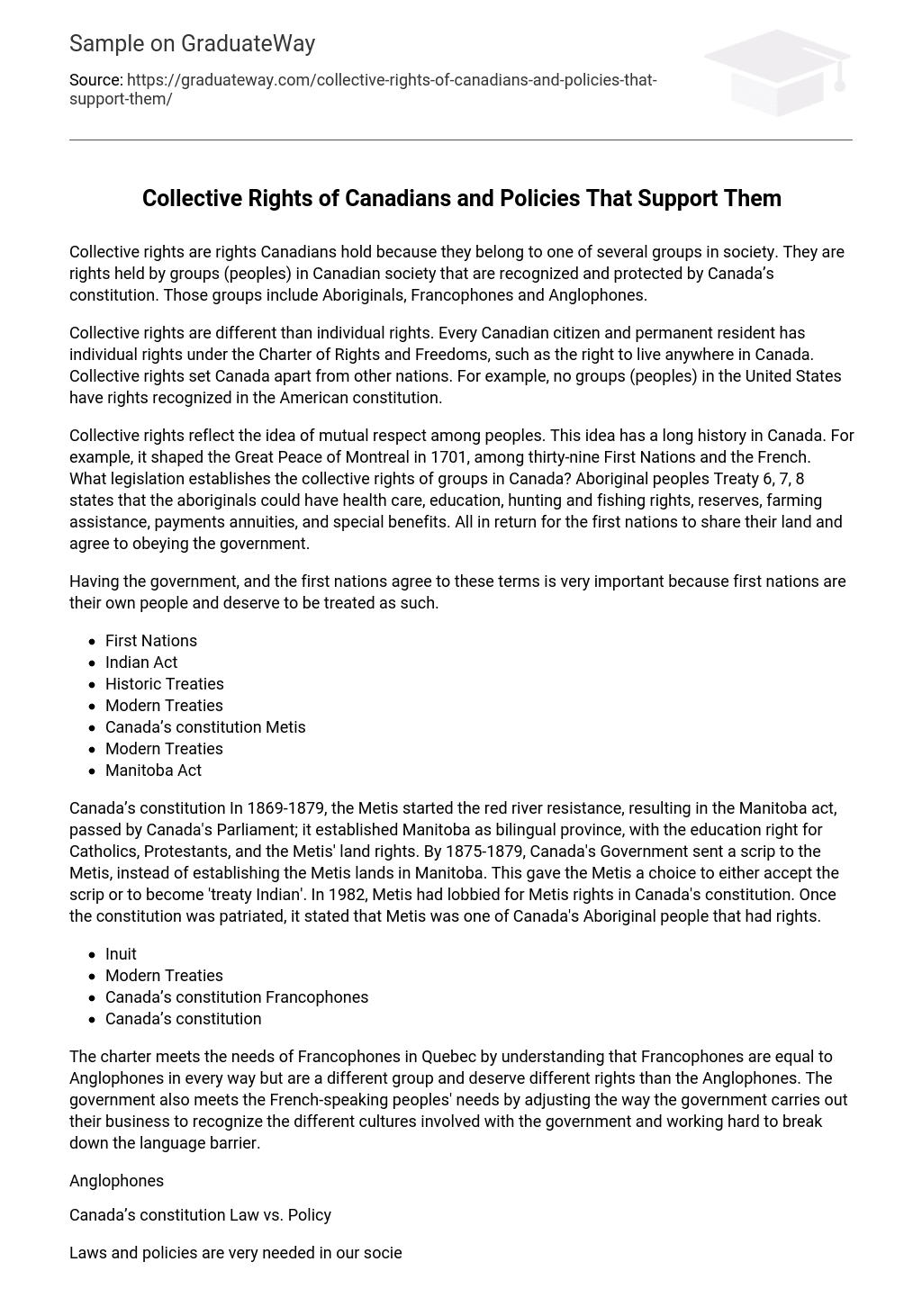Collective rights are rights Canadians hold because they belong to one of several groups in society. They are rights held by groups (peoples) in Canadian society that are recognized and protected by Canada’s constitution. Those groups include Aboriginals, Francophones and Anglophones.
Collective rights are different than individual rights. Every Canadian citizen and permanent resident has individual rights under the Charter of Rights and Freedoms, such as the right to live anywhere in Canada. Collective rights set Canada apart from other nations. For example, no groups (peoples) in the United States have rights recognized in the American constitution.
Collective rights reflect the idea of mutual respect among peoples. This idea has a long history in Canada. For example, it shaped the Great Peace of Montreal in 1701, among thirty-nine First Nations and the French. What legislation establishes the collective rights of groups in Canada? Aboriginal peoples Treaty 6, 7, 8 states that the aboriginals could have health care, education, hunting and fishing rights, reserves, farming assistance, payments annuities, and special benefits. All in return for the first nations to share their land and agree to obeying the government.
Having the government, and the first nations agree to these terms is very important because first nations are their own people and deserve to be treated as such.
- First Nations
- Indian Act
- Historic Treaties
- Modern Treaties
- Canada’s constitution Metis
- Modern Treaties
- Manitoba Act
Canada’s constitution In 1869-1879, the Metis started the red river resistance, resulting in the Manitoba act, passed by Canada’s Parliament; it established Manitoba as bilingual province, with the education right for Catholics, Protestants, and the Metis’ land rights. By 1875-1879, Canada’s Government sent a scrip to the Metis, instead of establishing the Metis lands in Manitoba. This gave the Metis a choice to either accept the scrip or to become ‘treaty Indian’. In 1982, Metis had lobbied for Metis rights in Canada’s constitution. Once the constitution was patriated, it stated that Metis was one of Canada’s Aboriginal people that had rights.
- Inuit
- Modern Treaties
- Canada’s constitution Francophones
- Canada’s constitution
The charter meets the needs of Francophones in Quebec by understanding that Francophones are equal to Anglophones in every way but are a different group and deserve different rights than the Anglophones. The government also meets the French-speaking peoples’ needs by adjusting the way the government carries out their business to recognize the different cultures involved with the government and working hard to break down the language barrier.
Anglophones
Canada’s constitution Law vs. Policy
Laws and policies are very needed in our society as they help in maintaining law and order in the society and help in shaping political and social aspects of the society. Though policies and laws can be interrelated, they are definitely two terms having different purposes. No nation can go forward without having certain laws and policies. A policy is that which outlines what a government is going to do and what it can achieve for the society as a whole. “Policy” also means what a government does not intend to do. It also evolves the principles that are needed for achieving the goal.
Policies are only documents and not law, but these policies can lead to new laws. Laws are set standards, principles, and procedures that must be followed in society. Law is mainly made for implementing justice in the society. There are various types of laws framed like criminal laws, civil laws, and international laws. While a law is framed for bringing justice to the society, a policy is framed for achieving certain goals. Laws are for the people, and policies are made in the name of the people. Policies can be called a set of rules that guide any government or any organization. Laws are administered through the courts.
Laws are enforceable in which the policies comply. A law is more formal as it is a system of rules and guidelines that are derived for the welfare and equity in society. A policy is just informal as it is just a statement or a document of what is intended to be done in the future. Why do some groups have collective rights and not others?
- Collective rights recognize the founding peoples of Canada. Canada would not exist today without the contribution of these peoples.
- Collective rights come from the roots of Aboriginal peoples, Francophones and Anglophones in the land and history of Canada. Certain groups have collective rights due to historical and constitutional reasons. Why are collective rights important to all Canadians?
Collective rights are important to all Canadians because each group in Canadian society is different in its own unique way; having collective rights is a lot like having an outfit completely custom made to fit your type of person and style; collective rights are manufactured to uphold each groups individual culture, style, and to meet every groups needs according to the groups’ unique structure. How do collective rights, in the past and today, define who we are as Canadians?
In the past, women and First Nations Peoples had been deprived of rights and privileges such as the right to take political action, celebrate and worship their own cultures and traditions, etc. Over the years, the people of Canada decided to take action and pressure the government to make changes to the charter so that all Canadians are treated with equity and equality. This has shaped who we are as a bicultural and bilingual country by alerting us of the unique groups of people in this nation and setting us into action to alternate our Charter of Rights and Freedoms to meet the needs of every group in Canada.





